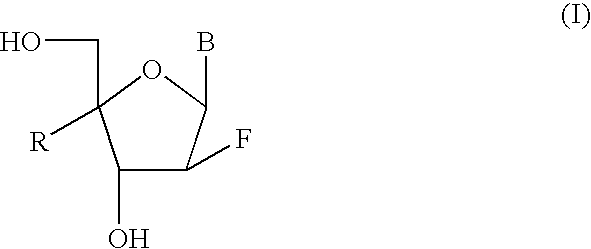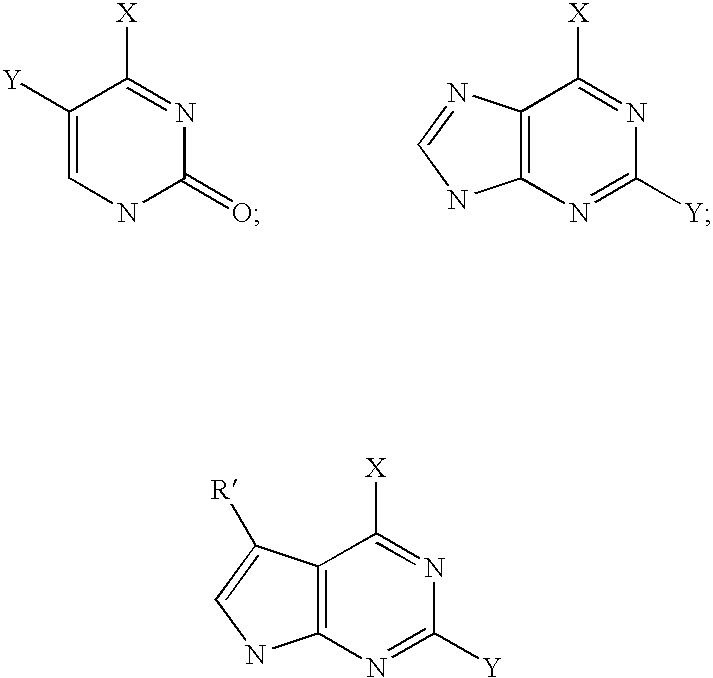2'-Fluorine-4'-Substituted-Nucleoside Analogues, Preparation Methods and Uses Thereof
a technology of nucleosides and fluorine, which is applied in the field of nucleoside analogues and preparation methods, can solve the problems of severe toxic and side effects, inability to cure patients, and inability to cure patients, and achieve the effect of reducing pressur
- Summary
- Abstract
- Description
- Claims
- Application Information
AI Technical Summary
Benefits of technology
Problems solved by technology
Method used
Image
Examples
example 1
The synthesis of the Compound 15 wherein the Base is Cytosine
[0050]The synthesis of compound ii: The compound i (D-ribose or L-ribose) (8.66 mmol) was dissolved in 31.2 ml HCl / MeOH (0.2 mmol / L), and the solution was stirred in a water bath at 27° C. for 3 hours under hermetization and warm preservation. The solution was added with 7.8 ml pyridine to terminate the reaction, and then drawn off under a reduced pressure, so as to obtain the light yellow syrup-like compound ii (96%);
[0051]The synthesis of compound iii: The compound ii (7.92 mmol) was dissolved in 21 ml dry pyridine, and 5.2 ml benzoyl chloride (0.0447 mol) was slowly added dropwise in the solution in an ice-salt bath. The solution was stirred at a room temperature for 17 hours. The reaction solution was poured into 39 ml ice water, and extracted with chloroform. The organic layer was washed sequentially with ice water, pre-cooled sulfuric acid (3 mol / L) and saturated sodium bicarbonate solution until the water layer show...
example 2
The synthesis of the Compounds 25, wherein the 4′-Substituted Group is Alkynes and the Base is 1,6-diamino-purine
[0065]The synthesis of compound b: Compound a (60 g) was added in acetone (2 L) and the concentrated sulfuric acid (40 ml) was slowly added while stirring. The solution was stirred for reaction at a room temperature for 40 minutes. After the reaction was detected by TLC as complete, the solution was added with the concentrated ammonia to adjust pH=7˜8, filtered, and evaporated under a reduced pressure to remove most of the acetone. The remaining acetone and water were about 150 ml. Then the solution was added with 0.4% dilute hydrochloric acid (150 ml) while being stirred, and the reaction was completed under the acetone reflux condition for 20 minutes until the compound a has been completely hydrolyzed into the compound b. After completion of the reaction, the reaction solution was neutralized to pH=7˜8 by solid NaHCO3, filtered, and evaporated to remove the solvent unde...
PUM
| Property | Measurement | Unit |
|---|---|---|
| Temperature | aaaaa | aaaaa |
| Temperature | aaaaa | aaaaa |
| Temperature | aaaaa | aaaaa |
Abstract
Description
Claims
Application Information
 Login to View More
Login to View More - R&D
- Intellectual Property
- Life Sciences
- Materials
- Tech Scout
- Unparalleled Data Quality
- Higher Quality Content
- 60% Fewer Hallucinations
Browse by: Latest US Patents, China's latest patents, Technical Efficacy Thesaurus, Application Domain, Technology Topic, Popular Technical Reports.
© 2025 PatSnap. All rights reserved.Legal|Privacy policy|Modern Slavery Act Transparency Statement|Sitemap|About US| Contact US: help@patsnap.com



